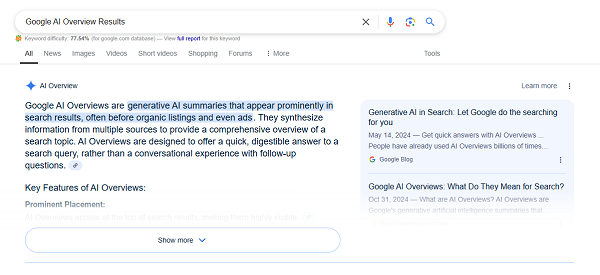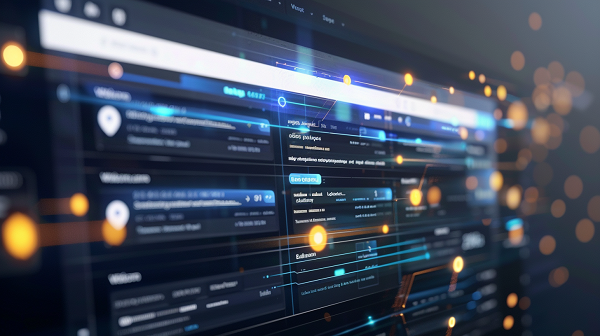Master JavaScript Web Scraping with Node.js & Residential Proxies
Learn how to scrape dynamic JavaScript websites using Node.js, Puppeteer, Playwright, and GoProxy’s residential proxies. Step-by-step tutorials included.
Apr 17, 2025
Learn to scrape Google AI Overview results using GoProxy’s residential proxies for SEO, market research, and ad insights with practical steps.
Google’s AI Overview block provides concise, AI-generated summaries for specific search queries, offering valuable insights into user intent and market trends. As highlighted in the provided document, this feature is currently limited to English searches in select countries, making it a critical data point for businesses aiming to optimize their SEO strategies or conduct market research. Scraping this data, however, presents challenges due to Google’s dynamic rendering and anti-bot measures. This article outlines actionable methods to scrape Google AI Overview results effectively, leveraging GoProxy’s residential proxies to ensure reliable, scalable data extraction.

Businesses, marketers, and developers seek Google AI Overview data for several reasons:
● SEO Optimization: Understanding AI-generated summaries helps refine content to align with Google’s ranking algorithms.
● Market Research: Extracting trends and consumer queries supports product development and competitive analysis.
● Advertising Insights: AI Overview data reveals high-intent keywords for targeted ad campaigns.
The challenge lies in bypassing Google’s restrictions, such as CAPTCHAs and IP bans, which is where GoProxy’s dynamic residential proxies excel, offering anonymity and global access.

1. Choose a Programming Language and Library: Python, paired with libraries like requests or selenium, is ideal for web scraping. For example:
python
import requests
proxies = {
"http": "http://user:[email protected]:port",
"https": "http://user:[email protected]:port"
}
response = requests.get("https://www.google.com/search?q=drop+shipping", proxies=proxies)
2. Integrate GoProxy Residential Proxies: GoProxy provides rotating residential IPs to mimic organic user behavior, reducing detection risks. Configure proxies with authentication credentials from GoProxy’s dashboard (Buy Residential Proxies - Get 7-Day Free Trial).
3. Handle Dynamic Content: Use selenium for JavaScript-rendered pages, ensuring the AI Overview block loads fully before extraction.
Why GoProxy? GoProxy’s residential proxies offer over 90 million IPs across 200+ countries, ensuring geographic flexibility for scraping region-specific AI Overviews.
1. Identify the AI Overview Block: The document shows AI Overview results in structured formats (paragraphs, lists, thumbnails). Use HTML parsing tools like BeautifulSoup to target these elements:
python
from bs4 import BeautifulSoup
soup = BeautifulSoup(response.text, 'html.parser')
ai_block = soup.find("div", class_="ai-overview")
2. Extract Structured Data: Capture text, lists, and references. For instance, the document lists steps for starting a drop-shipping business, which can be programmatically saved as JSON.
3. Validate Data: Cross-check extracted snippets against reference links (e.g., Shopify, Wikipedia) to ensure accuracy.
GoProxy Advantage: GoProxy’s high-speed connections minimize latency, enabling efficient parsing of large datasets without timeouts.
1. Automate Queries: Use a loop to scrape multiple keywords (e.g., “drop shipping,” “success quotes”). Store results in a database like MongoDB.
2. Rotate Proxies: GoProxy’s API allows seamless IP rotation to avoid rate limits:
python
from goproxy_api import GoProxyClient
client = GoProxyClient(api_key="your_api_key")
new_proxy = client.get_new_ip()
3. Monitor Success Rates: Track scrape success and adjust proxy settings if CAPTCHAs appear frequently.
GoProxy’s Scalability: With unlimited bandwidth and concurrent connections, GoProxy supports high-volume scraping for enterprise needs.

Scraping Google AI Overview results involves overcoming several hurdles:
● Dynamic Rendering: Google’s JavaScript-heavy pages require tools like selenium, which GoProxy supports by ensuring stable connections.
● Geographic Restrictions: The document notes AI Overviews are limited to specific countries. GoProxy’s global IP pool allows targeting these regions effortlessly.
● Anti-Bot Measures: Google’s CAPTCHAs and IP bans can disrupt scraping. GoProxy’s residential proxies, sourced from real devices, maintain a low detection footprint.
GoProxy’s Edge: Unlike datacenter proxies, GoProxy’s residential IPs blend into organic traffic, reducing bans. Its 24/7 support and dashboard analytics help optimize proxy performance for scraping tasks.
● SEO Agencies: Extract AI Overview data to identify trending keywords, enhancing client rankings.
● E-commerce Platforms: Scrape drop-shipping insights to source trending products.
● Ad Tech Companies: Use AI Overview data to refine ad targeting, leveraging GoProxy’s proxies for compliance with ad platform policies.
By integrating GoProxy’s residential proxies, users can execute these tasks with precision, ensuring data integrity and operational efficiency.
Google’s AI Overview block uses dynamic rendering and anti-bot measures like CAPTCHAs. GoProxy’s residential proxies mimic real user behavior, bypassing these restrictions with rotating IPs from over 90 million global addresses.
As the document notes, AI Overviews are limited to English searches in select countries. GoProxy’s proxies cover 200+ countries, allowing users to target specific regions by selecting IPs from the desired locale via the dashboard.
Yes, GoProxy’s unlimited bandwidth and concurrent connections support bulk scraping. For ad tech, its dynamic residential proxies ensure compliance with platforms like Google Ads, minimizing IP flags during data collection
Python libraries like requests, BeautifulSoup, and selenium work seamlessly with GoProxy. Users can configure proxies to handle JavaScript rendering, extracting structured data like lists and paragraphs efficiently.
CAPTCHAs arise from repetitive requests. GoProxy’s rotating residential IPs reduce detection risks, and its API allows instant IP switches, maintaining uninterrupted scraping sessions.
The document underscores the value of AI Overview data for understanding Google’s evolving search landscape. As Google expands this feature beyond English and select regions, demand for scalable scraping solutions will grow. GoProxy’s infrastructure is well-positioned to adapt, offering flexible APIs and robust proxy pools. Future advancements may include AI-driven proxy optimization, where GoProxy could predict optimal IPs for specific scraping tasks, further enhancing efficiency.
< Previous
Next >
 Cancel anytime
Cancel anytime No credit card required
No credit card required